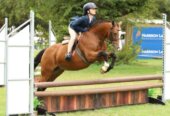
Cambridge will get its own galloping race track in the near future – only Cambridge’s one will be synthetic.
Work on the country’s first synthetic racetrack is set to start next month, the Cambridge News understands.
The project – which could cost up to $70 million – will make the region a national pacesetters in racing, rowing and cycling.
It is understood laying of the synthetic surface will commence in May 2020 and it could be in use three months later.
Racing officials are reluctant to discuss details, but it is understood some information was provided at a meeting at the Cambridge Jockey Club this week.
An all-weather, synthetic racetrack will replace the existing track at the Cambridge Jockey Club grounds on Racecourse Rd, home of New Zealand’s largest racehorse training facility with 800-1200 horses training there each month.
Once completed, it will become a regular facility for mid-week race meetings.
The News understands racing minister Winston Peters is preparing to announce funding approval for the new track surface.
It comes as the Racing Industry Transition Agency (RITA) welcomed the Government’s introduction of the Racing Industry Bill – a major package of reforms to replace the Racing Act 2003.
The Bill, which was introduced last week, had its first reading on Tuesday. RITA Chairman Dean McKenzie said the introduction of the bill is a significant milestone for racing and will help achieve the ambitious goals set by John Messara to ensure the sustainability of the racing industry.
Racing contributes $1.6 billion to the economy and provides 14000 jobs.
“Cambridge is leading in a lot of sporting areas and racing is one of them,” leading Cambridge trainer Shaune Ritchie, who works out of the Racecourse Rd training track, said.
“We need a track that can handle the amount of horses that we’ve got coming through, we’re the biggest training centre in Australasia.
“The racing industry is so important for the local town… already with Cambridge having those big studs, breeding a thousand horses – you need riders for those horses, you need fences, and that’s all supplied by the local community. And then clients come and stay in the hotels and motels during track work… so it’s all a big contributor for Cambridge, and it’s only going to get busier, especially with the races on.”
The synthetic track will be made from a sand and polymer binder with a fibre cushion surface and porous drainage base.
It is understood part of the funding, $7 million, will be covered by the Government’s Provincial Growth Fund.
The News understands civil works will commence next month and the first of site machinery, a plough, is due to be moved on it next week.
Camex will be the civil contractor on the project, with Australian company Polytrack set to install the synthetic surface.
Te Awamutu trainer Clayton Chipperfield was in full support of the project.

Clayton Chipperfield, pictured at the Priscott training site on Storey Rd with New Zealand’s leading three-year-old galloper Catalyst.
“I think it’s a great idea, centralising all the stables in one spot and just having your 52 mid-week meetings on the one course every week, rather than travel all over the Waikato,” he said. “It would certainly make it a lot easier on the horses, the trainers, and staff.”
It makes sense for the Waikato, he said, being a leading region for thoroughbred racing. “Obviously you’d still have your main premier meetings at Ellerslie, Matamata and Te Rapa, but the midweek meetings all in one spot would be ideal.”
Some figures in the industry were unsure how horses would react to the synthetic surface, but Chipperfield – who rotates horses between summer and winter based on their wet or dry track preference – could see the benefit.
“With synthetic tracks you know what you’re racing on, you expect the same track every time you go to the races, you know what to expect. At the moment you have all sorts of tracks and they’re all different, some of the are absolutely terrible in winter. But at least with a synthetic track, an all-weather track, it’s going to be the same turf every time.”
The Cambridge Jockey Club said it appreciated the support of leading stables around New Zealand which had recognised the need for a synthetic track at Cambridge.
A feasibility study is also being conducted to look at the possibility of the Cambridge Jockey Club, the Te Rapa Racing Club and Te Awamutu’s Waipa Racing Club joining forces at a greenfield site, possibly in Cambridge, with state-of-the-art facilities and a ‘mega track’ of sorts being built.
Cambridge Jockey Club President Bruce Harvey said the idea was still very much in the early preliminary stages and couldn’t provide too many details.
“But we all agree the industry needs something new,” he said. “It’s just a matter of looking at the feasibility, crunching the numbers and seeing whether it’s doable.”
The go-ahead on the project should be determined over the next few weeks, he said.








